Italians Whom Have Impacted Our Lives, Our Art, Our Architecture, Our Education, Our Science, Our Food, Our Cooking, Our Driving, Our Fashion, Our Entertainment, Our Intellect,
Our World...
|
|
There are many, many Italians whom throughout history have had
significant impact on our world - the
list of over 90 biographies (in the animated list to the left)
and those below shall continue to be expanded over time - if
you do not see your favorite Italian, kindly
send us a note and we shall
endeavor to add them to this reference -- |
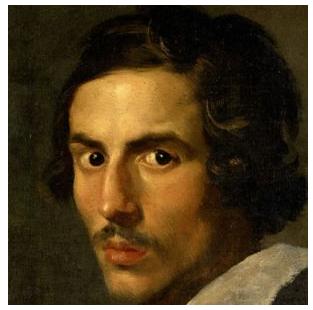 Giovanni Bernini Giovanni Bernini
Architect,
Artist,
Sculptor
(1598–1680)
Born in Naples in 1598
Birth Date - 7 December 1598
Died - 28 November 1680
Gian Lorenzo Bernini, was an Italian sculptor and architect. While a
major figure in the world of architecture, he was the leading
sculptor of his age, credited with creating the Baroque style of
sculpture. As one scholar has commented, "What Shakespeare is to
drama, Bernini may be to sculpture: the first pan-European sculptor
whose name is instantaneously identifiable with a particular manner
and vision, and whose influence was inordinately powerful...." In
addition, he was a painter (mostly small canvases in oil) and a man
of the theater: he wrote, directed and acted in plays (mostly
Carnival satires), also designing stage sets and theatrical
machinery, as well as a wide variety of decorative art objects
including lamps, tables, mirrors, and even coaches. As architect and
city planner, he designed both secular buildings and churches and
chapels, as well as massive works combining both architecture and
sculpture, especially elaborate public fountains and funerary
monuments and a whole series of temporary structures (in stucco and
wood) for funerals and festivals.
Bernini possessed the
ability to depict dramatic narratives with characters showing
intense psychological states, but also to organize large-scale
sculptural works which convey a magnificent grandeur. His skill
in manipulating marble ensured that he would be considered a worthy
successor of Michelangelo, far outshining other sculptors of his
generation, including his rivals, François Duquesnoy and Alessandro
Algardi. His talent extended beyond the confines of sculpture to a
consideration of the setting in which it would be situated; his
ability to synthesize sculpture, painting, and architecture into a
coherent conceptual and visual whole has been termed by the art
historian Irving Lavin the "unity of the visual arts". In
addition, a deeply religious man, working in Counter Reformation
Rome, Bernini used light both as an important theatrical and
metaphorical device in his religious settings, often using hidden
light sources that could intensify the focus of religious worship
or enhance the dramatic moment of a sculptural narrative.
Bernini was also a leading figure in the emergence of Roman Baroque
architecture along with his contemporaries, the architect Francesco
Borromini and the painter and architect Pietro da Cortona. Early in
their careers they had all worked at the same time at the Palazzo
Barberini, initially under Carlo Maderno and, following his death,
under Bernini. Later on, however, they were in competition for
commissions, and fierce rivalries developed, particularly between
Bernini and Borromini.
Despite the arguably greater
architectural inventiveness of Borromini and Cortona, Bernini's
artistic pre-eminence, particularly during the reigns of popes Urban
VIII (1623–44) and Alexander VII (1655–65), meant he was able to
secure the most important commissions in the Rome of his day, the
various massive embellishment projects of the newly finished St.
Peter's Basilica, completed under Pope Paul V with the addition of
Maderno's nave and facade and finally re-consecrated by Pope Urban
VIII on 18 November 1626, after 150 years of planning and building.
Bernini's design of the Piazza San Pietro in front of the Basilica
is one of his most innovative and successful architectural designs.
Within the basilica he is also responsible for the Baldacchino, the
decoration of the four piers under the cupola, the Cathedra Petri or
Chair of St. Peter in the apse, the chapel of the Blessed Sacrament
in the right nave, and the decoration (floor, walls and arches) of
the new nave.
During his long career, Bernini received
numerous important commissions, many of which were associated with
the papacy. At an early age, he came to the attention of the papal
nephew, Cardinal Scipione Borghese, and in 1621, at the age of only
twenty-three, he was knighted by Pope Gregory XV. Following his
accession to the papacy, Urban VIII is reported to have said, "It is
a great fortune for you, O Cavaliere, to see Cardinal Maffeo
Barberini made pope, but our fortune is even greater to have
Cavalier Bernini alive in our pontificate."[10] Although he did not
fare so well during the reign of Innocent X, under Alexander VII, he
once again regained pre-eminent artistic domination and continued to
be held in high regard by Clement IX.
|
|
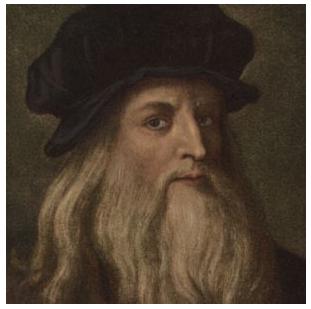 Leonardo da Vinci Leonardo da Vinci
Artist, Scientist,Mathematician, Inventor, Author
Born: 15 APR 1452, Vinci, Italy
Death: 2 MAY 1519, Amboise, France
Most people associated Leonardo da Vinci for his artwork of The Last Supper
and Mona Lisa paintings but this
Italian was the epitome of the Renaissance.
Possessor of a curious mind and keen intellect, da Vinci
studied the laws of science and nature, which greatly informed
his work as a painter, sculptor, architect, inventor, military
engineer and draftsman. His ideas and body of work which
includes "Virgin of the Rocks," "The Last Supper" and "Mona
Lisa" - have influenced countless artists and made da Vinci a
leading light of the Italian Renaissance. Leonardo da Vinci was
born in a farmhouse nestled amid the
undulating hills of Tuscany outside the village of Anchiano in
present-day Italy. Born out of wedlock to respected Florentine
notary Ser Piero and a young peasant woman named Caterina, he
was raised by his father and his stepmothers. At the age of
five, he moved to his father's family estate in nearby Vinci,
the Tuscan town from which the surname associated with Leonardo
derives, and lived with his uncle and grandparents.
Young Leonardo received little formal education beyond basic
reading, writing and mathematics instruction, but his artistic
talents were evident from an early age. Around the age of 14, da
Vinci began a lengthy apprenticeship with the noted artist
Andrea del Verrocchio in Florence. He learned a wide breadth of
technical skills including metalworking, leather arts,
carpentry, drawing, painting and sculpting. His earliest known
dated work, a pen-and-ink drawing of a landscape in the Arno
valley was sketched in 1473.
At the age of 20, da Vinci
qualified for membership as a master artist in Florence's Guild
of Saint Luke and established his own workshop. However, he
continued to collaborate with his teacher for an additional five
years. It is thought that Verrocchio completed his "Baptism of
Christ" around 1475 with the help of his student, who painted
part of the background and the young angel holding the robe of
Jesus. According to Lives of the Most Excellent Painters,
Sculptors and Architects, written around 1550 by artist Giorgio
Vasari, Verrocchio was so humbled by the superior talent of his
pupil that he never picked up a paintbrush again. Most scholars,
however, dismiss Vasari's account as apocryphal.
After
leaving Verrocchio's studio, da Vinci received his first
independent commission in 1478 for an altarpiece to reside in a
chapel inside Florence's Palazzo Vecchio. Three years later the
Augustinian monks of Florence's San Donato a Scopeto tasked him
to paint "Adoration of the Magi." The young artist, however,
would leave the city and abandon both commissions without ever
completing them.
In 1482, another famous Italian and
Florentine ruler, Lorenzo de' Medici,
commissioned da Vinci to create a silver lyre and
bring it as a peace gesture to Ludovico Sforza, who ruled Milan
as its regent. After doing so, da Vinci lobbied Ludovico for a
job and sent the future Duke of Milan a letter that barely
mentioned his considerable talents as an artist and instead
touted his more marketable skills as a military engineer. Using
his inventive mind, da Vinci sketched war machines such as a war
chariot with scythe blades mounted on the sides, an armored tank
propelled by two men cranking a shaft and even an enormous
crossbow that required a small army of men to operate. The
letter worked, and Ludovico brought da Vinci to Milan for a
tenure that would last 17 years.
His ability to be
employed by the Sforza clan as an architecture and military
engineering advisor as well as a painter and sculptor spoke to
da Vinci's keen intellect and curiosity about a wide variety of
subjects. Like many leaders of Renaissance humanism, da Vinci
did not see a divide between science and art. He viewed the two
as intertwined disciplines rather than separate ones. He
believed studying science made him a better artist.
Leonardo thought sight was humankind's most important sense and
eyes the most important organ. He stressed the importance of
saper vedere, knowing how to see. He believed in the
accumulation of direct knowledge and facts through observation.
A good painter has two chief objects to paint - man and the
intention of his soul, da Vinci wrote. The former is easy, the
latter hard, for it must be expressed by gestures and the
movement of the limbs. To more accurately depict those gestures
and movements, da Vinci began to seriously study anatomy and
dissect human and animal bodies during the 1480s. His drawings
of a fetus in utero, the heart and vascular system, sex organs
and other bone and muscular structures are some of the first on
human record.
In addition to his anatomical
investigations, da Vinci studied botany, geology, zoology,
hydraulics, aeronautics and physics. He sketched his
observations on loose sheets of papers and pads that he tucked
inside his belt. He placed the papers in notebooks and arranged
them around four broad themes, painting, architecture, mechanics
and human anatomy. He filled dozens of notebooks with finely
drawn illustrations and scientific observations. His ideas were
mainly theoretical explanations, laid out in exacting detail,
but they were rarely experimental.
Art and
science intersected perfectly in his sketch of "Vitruvian Man,"
which depicted a male figure in two superimposed positions with
his arms and legs apart inside both a square and a circle. A man
ahead of his time, da Vinci appeared to prophesize the future
with his sketches of machines resembling a bicycle, helicopter
and a flying machine based on the physiology of a bat.
|
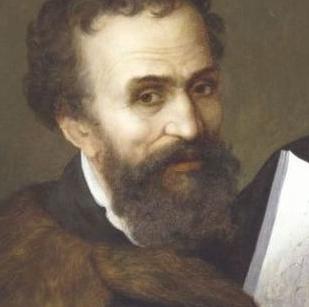 Michelangelo Michelangelo
Michelangelo di
Lodovico Buonarroti Simoni
Painter,
Architect,
Poet, Sculptor
(1475–1564)
Born: March 6, 1475, Caprese (Republic of Florence), Italy
Death: February 18, 1564, Rome, Italy
Michelangelo, the "Father and Master of All the Arts"
is widely regarded as the most famous artist of the Italian
Renaissance. Among his works are the "David" and "Pieta" statues
and the Sistine Chapel frescoes.
Michelangelo was born on March 6, 1475, in
Caprese, Italy. Born to a family of moderate means in the banking
business, Michelangelo became an apprentice to a painter before
studying in the sculpture gardens of the powerful Medici family.
What followed was a remarkable career as an artist in the Italian
Renaissance, recognized in his own time for his artistic virtuosity.
His works include the "David" and "Pieta" statues and the ceiling
paintings of Rome's Sistine Chapel, including the "Last Judgment."
Although he always considered himself a Florentine, Michelangelo
lived most of his life in Rome, where he died in 1564, at age 88.
Young Michelangelo
Painter, sculptor, architect and poet
Michelangelo, one of the most famous artists of the Italian
Renaissance, was born Michelangelo di Lodovico Buonarroti Simoni on
March 6, 1475, in Caprese, Italy. Michelangelo's father, Leonardo di
Buonarrota Simoni, was briefly serving as a magistrate in the small
village when he recorded the birth of his second of five sons with
his wife, Francesca Neri, but they returned to Florence when
Michelangelo was still an infant. Due to his mother's illness,
however, Michelangelo was placed with a family of stonecutters,
where he later jested, "With my wet-nurse's milk, I sucked in the
hammer and chisels I use for my statues."
Indeed, Michelangelo was less interested in
schooling than watching the painters at nearby churches, and drawing
what he saw there, according to his earliest biographers (Vasari,
Condivi and Varchi). It may have been his grammar school friend,
Francesco Granacci, six years his senior, who introduced
Michelangelo to painter Domenico Ghirlandaio. Michelangelo's father
realized early on that his son had no interest in the family
financial business, so agreed to apprentice him, at the age of 13,
to the fashionable Florentine painter's workshop. There,
Michelangelo was exposed to the technique of fresco.
Michelangelo had spent only a year at the
workshop when an extraordinary opportunity opened to him: At the
recommendation of Ghirlandaio, he moved into the palace of
Florentine ruler Lorenzo the Magnificent, of the powerful Medici
family, to study classical sculpture in the Medici gardens. This was
a fertile time for Michelangelo; his years with the Medici family,
1489 to 1492, permitted him access to the social elite of
Florence—allowing him to study under the respected sculptor Bertoldo
di Giovanni and exposing him to prominent poets, scholars and
learned Humanists. He also obtained special permission from the
Catholic Church to study cadavers for insight into anatomy, though
exposure to corpses had an adverse effect on his health.
These combined influences laid the groundwork for
what would become Michelangelo's distinctive style: a muscular
precision and reality combined with an almost lyrical beauty. Two
relief sculptures that survive, "Battle of the Centaurs" and
"Madonna Seated on a Step," which are testaments to his unique
talent at the unbelievable age of only sixteen.
|
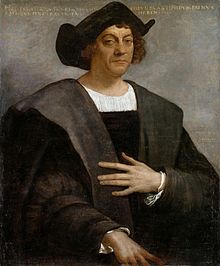 Christopher Columbus Christopher Columbus
Born (birth records are inexact, believed to be prior to) 31
October 1451, on Genoa, Republic of Genoa and died 20 May 1506
Columbus was an extraordinary Italian explorer, navigator,
colonizer, and citizen of the Republic of Genoa. Under the auspices of
the Catholic Monarchs of Spain, he completed four voyages across the
Atlantic Ocean. He was well known at the time as being the most acute
dead-reckoning navigator (the ability to navigate using
only a compass) of that age. His voyages and his efforts to
establish permanent settlements on the island of Hispaniola initiated
the European colonization of the New World. Which in pertinent part is a
primary reason you are even able to be reading this right now.
His name in Italian is Cristoforo Colombo and,
in Spanish, it is Cristóbal Colón. He was born
before 31 October 1451 in the territory of the Republic of Genoa (now
part of modern Italy), though the exact location remains disputed. His
father was Domenico Colombo, a middle-class wool weaver who worked both
in Genoa and Savona and who also owned a cheese stand at which young
Christopher worked as a helper. His mother was Susanna Fontanarossa.
Bartolomeo, Giovanni Pellegrino, and Giacomo were his brothers.
Bartolomeo worked in a cartography workshop in Lisbon for at least part
of his adulthood. He also had a sister named Bianchinetta.
Columbus never wrote in his native language, which is presumed to have
been a Genoese variety of Ligurian (his name would translate in the
16th-century Genoese language as Christoffa Corombo. In one of his
writings, he says he went to sea at the age of 10. In 1470, the Columbus
family moved to Savona, where Domenico took over a tavern. In the same
year, Christopher was on a Genoese ship hired in the service of René of
Anjou to support his attempt to conquer the Kingdom of Naples. Some
modern historians have argued that he was not from Genoa but, instead,
from the Aragon region of Spainor from Portugal. These competing
hypotheses have generally been discounted by mainstream scholars.
Columbus's handwritten notes in Latin, on the margins of his copy of The
Travels of Marco Polo
In 1473, Columbus began his apprenticeship
as business agent for the important Centurione, Di Negro and Spinola
families of Genoa. Later, he allegedly made a trip to Chios, an Aegean
island then ruled by Genoa. In May 1476, he took part in an armed convoy
sent by Genoa to carry valuable cargo to northern Europe. He docked in
Bristol, England and Galway, Ireland. In 1477, he was possibly in
Iceland. In the autumn of 1477, he sailed on a Portuguese ship from
Galway to Lisbon, where he found his brother Bartolomeo, and they
continued trading for the Centurione family. Columbus based himself in
Lisbon from 1477 to 1485. He married Filipa Moniz Perestrelo, daughter
of the Porto Santo governor and Portuguese nobleman of Lombard origin
Bartolomeu Perestrello.
In retrospect, we were inaccurately
taught in school that Columbus discovered "America", while he
actually landed on an island now known as Hisaniola and became the first
"Spanish authorized" governor of that land. More below.
One of
the driving reasons for Columbus' voyage to the new world was that
Western imperialism and economic competition were emerging among
European kingdoms through the establishment of trade routes and
colonies. Columbus was actually looking for a western route to Japan and
the orient (at the time referred to asa the "East Indies") by sailing
westward as the military governments in Constantinole had controlled all
of the well known routes to China and the east.
Columbus
eventually received the support of the Spanish Crown for this voyage
whom at the time was in fierce competition with England to colunize the
new world lands.
Spain saw a chance to enter the spice trade with
Asia through a new westward route. During his first voyage in 1492, he
reached the New World instead of arriving at Japan as he had intended.
He landed on an island in the Bahamas archipelago that he named "San
Salvador" and known today as Hispaniola. Over the course of three more
voyages, he visited the Greater and Lesser Antilles, as well as the
Caribbean coast of Venezuela and Central America, claiming all of it for
the Crown of Castile (Spain).
We now know today that Columbus was
not the first European explorer to reach the Americas, having been
preceded by the Viking expedition led by Leif Erikson in the 11th
century, but his voyages led to the first lasting European contact with
the Americas, inaugurating a period of European exploration, conquest,
and colonization that lasted several centuries.
These voyages
had, therefore, an enormous impact in the historical development of the
modern Western world. Columbus himself saw his accomplishments primarily
in the light of spreading the Christian religion.
Columbus called
the inhabitants of the lands that he visited indios (Spanish for
"Indians"). His strained relationship with the Spanish crown and the
appointed colonial administrators in America, led to his dismissal as
governor of the settlements on the island of Hispaniola in 1500 - gotta
love politics...
|
 Amerigo Vespucci Amerigo Vespucci
Portrait of Vespucci which
titles him "discoverer and conqueror of Brazilian land"
March 9, 1454 – February 22, 1512
Amerigo was an Italian
explorer, financier, navigator and cartographer who first demonstrated
that Brazil and the West Indies did not represent Asia's eastern
outskirts as initially conjectured from Columbus' voyages, but instead
constituted an entirely separate landmass hitherto unknown to Old
Worlders.
Colloquially referred to as the New World, this second
super continent came to be termed "Americas", deriving its name from
Americus, the Latin version of Vespucci's first name.
Amerigo
Vespucci was born and raised in Florence on the Italian Peninsula. He
was the third son of Ser Nastagio (Anastasio) Vespucci, a Florentine
notary, and Lisabetta Mini. The father of Ser Nastagio (Anastasio)
Vespucci had the name Amerigo Vespucci also.
Amerigo Vespucci was
educated by his uncle, Fra Giorgio Antonio Vespucci, a Dominican friar
of the monastery of San Marco in Florence. While his elder brothers were
sent to the University of Pisa to pursue scholarly careers, Amerigo
Vespucci embraced a mercantile life, and was hired as a clerk by the
Florentine commercial house of Medici, headed by Lorenzo de' Medici.
Vespucci acquired the favor and protection of Lorenzo di Pierfrancesco
de' Medici who became the head of the business after the elder Lorenzo's
death in 1492. In March 1492, the Medici dispatched the
thirty-eight-year-old Vespucci and Donato Niccolini as confidential
agents to look into the Medici branch office in Cádiz (Spain), whose
managers and dealings were under suspicion. In April 1495, by the
intrigues of Bishop Juan Rodríguez de Fonseca, the Crown of Castile
broke their monopoly deal with Christopher Columbus and began handing
out licenses to other navigators for the West Indies. Just around this
time (1495–96), Vespucci was engaged as the executor of Giannotto
Berardi, an Italian merchant who had recently died in Seville. Vespucci
organized the fulfillment of Berardi's outstanding contract with the
Castilian crown to provide twelve vessels for the Indies. After these
were delivered, Vespucci continued as a provision contractor for Indies
expeditions, and is known to have secured beef supplies for at least one
(if not two) of Columbus' voyages.
At the invitation of king
Manuel I of Portugal, Vespucci participated as observer in several
voyages that explored the east coast of South America between 1499 and
1502. On the first of these voyages he was aboard the ship that
discovered that South America extended much further south than
previously thought.
The expeditions became widely known in Europe
after two accounts attributed to Vespucci were published between 1502
and 1504. In 1507, Martin Waldseemüller produced a world map on which he
named the new continent America after the feminine Latin version of
Vespucci's first name, which is Americus.
In 1508, the position
of chief of navigation of Spain (piloto mayor de Indias) was created for
Vespucci, with the responsibility of planning navigation for voyages to
the Indies.
Vespucci's first encounter with Native Americans in
Honduras, 1497 (De Bry's illustration, c.1592)
Two letters
attributed to Vespucci were published during his lifetime. Mundus Novus
(New World) was a Latin translation of a lost Italian letter sent from
Lisbon to Lorenzo di Pierfrancesco de' Medici. It describes a voyage to
South America in 1501–1502. Mundus Novus was published in late 1502 or
early 1503 and soon reprinted and distributed in numerous European
countries. Lettera di Amerigo Vespucci delle isole nuovamente trovate in
quattro suoi viaggi (Letter of Amerigo Vespucci concerning the isles
newly discovered on his four voyages), known as Lettera al Soderini or
just Lettera, was a letter in Italian addressed to Piero Soderini.
Printed in 1504 or 1505, it claimed to be an account of four voyages to
the Americas made by Vespucci between 1497 and 1504. A Latin translation
was published by the German Martin Waldseemüller in 1507 in
Cosmographiae Introductio, a book on cosmography and geography, as
Quattuor Americi Vespucij navigationes (Four Voyages of Amerigo
Vespucci).
On March 22, 1508, King Ferdinand made Vespucci chief
navigator of Spain at a huge salary and commissioned him to found a
school of navigation, in order to standardize and modernize navigation
techniques used by Iberian sea captains then exploring the world.
Vespucci even developed a rudimentary, but fairly accurate method of
determining longitude (which only more accurate chronometers would later
improve upon).
The first known depiction of cannibalism in the New
World. Engraving by Johann Froschauer for an edition of Amerigo
Vespucci's Mundus Novus, published in Augsburg in 1505
In the
18th century, three unpublished familiar letters from Vespucci to
Lorenzo de' Medici were rediscovered. One describes a voyage made in
1499–1500 which corresponds with the second of the "four voyages".
Another was written from Cape Verde in 1501 in the early part of the
third of the four voyages, before crossing the Atlantic. The third
letter was sent from Lisbon after the completion of that voyage.
Some have suggested that Vespucci, in the two letters published in his
lifetime, was exaggerating his role and constructed deliberate
fabrications. However, many scholars now believe that the two letters
were not written by him but were fabrications by others based in part on
genuine letters by Vespucci. It was the publication and widespread
circulation of the letters that might have led Waldseemüller to name the
new continent America on his world map of 1507 in Lorraine. Vespucci
used a Latinised form of his name, Americus Vespucius, in his Latin
writings, which Waldseemüller used as a base for the new name, taking
the feminine form America, according to the prevalent view. The book
accompanying the map stated: "I do not see what right any one would have
to object to calling this part, after Americus who discovered it and who
is a man of intelligence, Amerige, that is, the Land of Americus, or
America: since both Europa and Asia got their names from women". It is
possible that Vespucci was not aware that Waldseemüller had named the
continent after him.
The two disputed letters claim that Vespucci
made four voyages to America, while at most two can be verified from
other sources. At the moment, there is a dispute between historians on
when Vespucci visited the mainland the first time. Some historians like
Germán Arciniegas and Gabriel Camargo Pérez think that his first voyage
was made in June 1497 with the Spanish Pilot Juan de la Cosa.
Vespucci's real historical importance may well rest more in his letters,
whether he wrote them all or not, than in his discoveries. From these
letters, the European public learned about the newly discovered
continents of the Americas for the first time; its existence became
generally known throughout Europe within a few years of the letters'
publication.
|
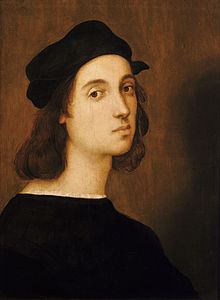 Raffaello Sanzio da UrbinoSome of Raphael's famous works Raffaello Sanzio da UrbinoSome of Raphael's famous works
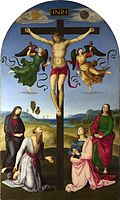
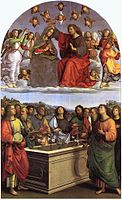 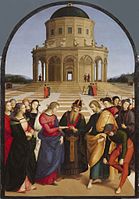
Raphael was born in the small but artistically significant central
Italian city of Urbino in the Marche region, where his father Giovanni
Santi was court painter to the Duke. The reputation of the court had
been established by Federico III da Montefeltro, a highly successful
condottiere who had been created Duke of Urbino by the Pope - Urbino
formed part of the Papal States - and who died the year before Raphael
was born. The emphasis of Federico's court was rather more literary than
artistic, but Giovanni Santi was a poet of sorts as well as a painter,
and had written a rhymed chronicle of the life of Federico, and both
wrote the texts and produced the decor for masque-like court
entertainments. His poem to Federico shows him as keen to show awareness
of the most advanced North Italian painters, and Early Netherlandish
artists as well. In the very small court of Urbino he was probably more
integrated into the central circle of the ruling family than most court
painters.
Federico was succeeded by his son Guidobaldo da
Montefeltro, who married Elisabetta Gonzaga, daughter of the ruler of
Mantua, the most brilliant of the smaller Italian courts for both music
and the visual arts. Under them, the court continued as a centre for
literary culture. Growing up in the circle of this small court gave
Raphael the excellent manners and social skills stressed by Vasari.
Court life in Urbino at just after this period was to become set as the
model of the virtues of the Italian humanist court through Baldassare
Castiglione's depiction of it in his classic work The Book of the
Courtier, published in 1528. Castiglione moved to Urbino in 1504, when
Raphael was no longer based there but frequently visited, and they
became good friends. He became close to other regular visitors to the
court: Pietro Bibbiena and Pietro Bembo, both later cardinals, were
already becoming well known as writers, and would be in Rome during
Raphael's period there. Raphael mixed easily in the highest circles
throughout his life, one of the factors that tended to give a misleading
impression of effortlessness to his career. He did not receive a full
humanistic education however; it is unclear how easily he read Latin.
Raphael led a "nomadic" life, working in various centres in Northern
Italy, but spent a good deal of time in Florence, perhaps from about
1504. Although there is traditional reference to a "Florentine period"
of about 1504 through 1508, he was possibly never a continuous resident
there. He may have needed to visit the city to secure materials in any
case. There is a letter of recommendation of Raphael, dated October
1504, from the mother of the next Duke of Urbino to the Gonfaloniere of
Florence: "The bearer of this will be found to be Raphael, painter of
Urbino, who, being greatly gifted in his profession has determined to
spend some time in Florence to study. And because his father was most
worthy and I was very attached to him, and the son is a sensible and
well-mannered young man, on both accounts, I bear him great love..."
As earlier with Perugino and others, Raphael was able to assimilate
the influence of Florentine art, whilst keeping his own developing
style. Frescos in Perugia of about 1505 show a new monumental quality in
the figures which may represent the influence of Fra Bartolomeo, who
Vasari says was a friend of Raphael. But the most striking influence in
the work of these years is Leonardo da Vinci, who returned to the city
from 1500 to 1506. Raphael's figures begin to take more dynamic and
complex positions, and though as yet his painted subjects are still
mostly tranquil, he made drawn studies of fighting nude men, one of the
obsessions of the period in Florence. Another drawing is a portrait of a
young woman that uses the three-quarter length pyramidal composition of
the just-completed Mona Lisa, but still looks completely Raphaelesque.
Another of Leonardo's compositional inventions, the pyramidal Holy
Family, was repeated in a series of works that remain among his most
famous easel paintings. There is a drawing by Raphael in the Royal
Collection of Leonardo's lost Leda and the Swan, from which he adapted
the contrapposto pose of his own Saint Catherine of Alexandria. He also
perfects his own version of Leonardo's sfumato modelling, to give
subtlety to his painting of flesh, and develops the interplay of glances
between his groups, which are much less enigmatic than those of
Leonardo. But he keeps the soft clear light of Perugino in his
paintings.
Leonardo was more than thirty years older than
Raphael, but Michelangelo, who was in Rome for this period, was just
eight years his senior. Michelangelo already disliked Leonardo, and in
Rome came to dislike Raphael even more, attributing conspiracies against
him to the younger man. Raphael would have been aware of his works in
Florence, but in his most original work of these years, he strikes out
in a different direction. His Deposition of Christ draws on classical
sarcophagi to spread the figures across the front of the picture space
in a complex and not wholly successful arrangement. Wöllflin detects the
influence of the Madonna in Michelangelo's Doni Tondo in the kneeling
figure on the right, but the rest of the composition is far removed from
his style, or that of Leonardo. Though highly regarded at the time, and
much later forcibly removed from Perugia by the Borghese, it stands
rather alone in Raphael's work. |
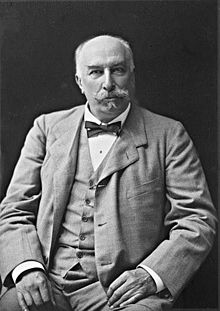 Giovanni Giolitti Giovanni Giolitti
Born October 27, 1842
Died July 17, 1928
Giovanni was
an Italian statesman and Prime Minister of Italy five times
between 1892 and 1921. He is the second-longest serving Prime
Minister in Italian history, after Benito Mussolini. He was a prominent
leader of the Historical Left and the Liberal Union. Giolitti is widely
considered one of the most powerful and important politicians in Italian
history and, due to his dominant position in Italian politics, he was
accused by critics of beign a parliamentary dictator.
Giolitti
was a master in the political art of Trasformismo, the method of making
a flexible, centrist coalition of government which isolated the extremes
of the left and the right in Italian politics after the unification.
Under his influence, the Italian Liberals did not develop as a
structured party, they were, instead, a series of informal personal
groupings with no formal links to political constituencies.[2] The
period between the start of the 20th century and the start of World War
I, when he was Prime Minister and Minister of the Interior from 1901 to
1914 with only brief interruptions, is often referred to as the
"Giolittian Era".
A left-wing liberal, with strong ethical
concerns, Giolitti's periods in office were notable for the passage of a
wide range of progressive social reforms which improved the living
standards of ordinary Italians, together with the enactment of several
policies of government intervention. Besides putting in place several
tariffs, subsidies and government projects, Giolitti also nationalized
the private telephone and railroad operators. Liberal proponents of free
trade criticized the "Giolittian System", although Giolitti himself saw
the development of the national economy as essential in the production
of wealth.
The primary objective of Giolittian politics was to
govern from the center with slight and well controlled fluctuations, now
in a conservative direction, then in a progressive one, trying to
preserve the institutions and the existing social order. His highly
complex legacy continues to stimulate intense debate amongst writers and
historians.
Giolitti was born at Mondovì (Piedmont). His father
Giovenale Giolitti had been working in the avvocatura dei poveri, an
office assisting poor citizens in both civil and criminal cases. He died
in 1843, a year after Giovanni was born. The family moved in the home of
his mother Enrichetta Plochiù in Turin.
His mother taught him to
read and write; his education in the gymnasium San Francesco da Paola of
Turin was marked by poor discipline and little commitment to study.[10]
He did not like mathematics and the study of Latin and Greek grammar,
preferring the history and reading the novels of Walter Scott and Honoré
de Balzac.[11] At sixteen he entered the University of Turin and, after
three years, he earned a law degree in 1860.
His uncle was a
member of the Parliament of the Kingdom of Sardinia and a close friend
of Michelangelo Castelli, the secretary of Camillo Benso di Cavour.
However Giolitti did not appear particularly interested in the
Risorgimento and differently to many of his fellow students, he did not
enlist to fight in the Italian Second War of Independence.
Career in
the public administration
Subsequently, he pursued a career in
public administration in the Ministry of Grace and Justice. That choice
prevented him from participating in the decisive battles of the
Risorgimento (the unification of Italy), for which his temperament was
not suited anyway, but this lack of military experience would be held
against him as long as the Risorgimento generation was active in
politics.
In 1869 he moved to the Ministry of Finance, becoming a
high official and working along with important members of the ruling
Right, like Quintino Sella and Marco Minghetti. In the same year he
married Rosa Sobrero, the granddaughter of Ascanio Sobrero, a famous
chemist, who discovered nitroglycerine.
In 1877 Giolitti was
appointed to the Court of Audit and in 1882 to the Council of State.
At the 1882 Italian general election he was elected to the Chamber
of Deputies (the lower house of Parliament) for the Historical Left.
This election was a great victory for the ruling Left of Agostino
Depretis, which won 289 seats out of 508.
As deputy he chiefly
acquired prominence by attacks on Agostino Magliani, Treasury Minister
in the cabinet of Depretis.
Following Depretis’s death on 29 July
1887 Francesco Crispi, a notable politician and patriot, became the
leader of the Left group and was also appointed Prime Minister by King
Umberto I.
On 9 March 1889 Giolitti was selected by Crispi as new
Minister of Treasury and Finance. But in October 1890, Giolitti resigned
from his office due to contrasts with Crispi's colonial policy. In fact
few weeks before, the Ethiopian Emperor Menelik II had contested the
Italian text of the Wuchale Treaty, signed by Crispi, stating that it
did not oblige Ethiopia to be an Italian protectorate. Menelik informed
the foreign press and the scandal erupted. .
After the fall of
the government led by the new Prime Minister Antonio Starabba di Rudinì
in May 1892, Giolitti, with the help of a court clique, received from
the King the task of forming a new cabinet. |
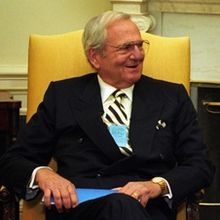 Lee Iacocca Lee Iacocca
Lido Anthony "Lee" Iacocca born October 15, 1924, is an American
automobile executive best known for spearheading the development of Ford
Mustang and Pinto cars, while at the Ford Motor Company in the 1960s,
and then later for reviving the Chrysler Corporation as its CEO during
the 1980s. He served as President and CEO of Chrysler from 1978 and
additionally as chairman from 1979, until his retirement at the end of
1992.
Iacocca was a passionate advocate of U.S. business exports
during the 1980s. He is the author (or co-author) of several books,
including Iacocca: An Autobiography (with William Novak), and Where Have
All the Leaders Gone?.
Portfolio named Iacocca the 18th-greatest
American CEO of all time.
Iacocca was born in Allentown,
Pennsylvania, to Nicola Iacocca and Antonietta Perrotta, Italian
immigrants (from San Marco dei Cavoti, Benevento) who had settled in
Pennsylvania's steel-production belt. They operated a restaurant,
Yocco's Hot Dogs. He was said to have been christened with the unusual
name "Lido" because he was conceived during his parents' honeymoon in
the Lido district in Venice. However, he refutes this rumor in his
autobiography, saying that is romantic but not true; his father went to
Lido long before his marriage and was traveling with his future wife's
brother.[3]
Iacocca graduated from Allentown High School (now
known as William Allen High School) in 1942, and Lehigh University in
neighboring Bethlehem, Pennsylvania, with a degree in industrial
engineering. He is a member of Tau Beta Pi, the engineering honor
society, and an alumnus of Theta Chi Fraternity.
After graduating
from Lehigh, he won the Wallace Memorial Fellowship and went to
Princeton University, where he took his electives in politics and
plastics. He then began a career at the Ford Motor Company as an
engineer.
Iacocca was strongly courted by the Chrysler
Corporation, at a time when the company appeared to be on the verge of
going out of business and had just sold its loss-making Chrysler Europe
division to Peugeot in an effort to generate cash because the company
was losing millions already in North America.[8] This was largely due to
recalls of its Dodge Aspen and Plymouth Volare, both of which Iacocca
later said should never have been built.[dubious – discuss] Iacocca
joined Chrysler and began rebuilding the entire company from the ground
up, laying off many workers, and bringing in many former associates from
his former company.
Also from Ford, Iacocca brought to Chrysler
the "Mini-Max" project, which, in 1983, bore fruit in the highly
successful Dodge Caravan and Plymouth Voyager. Henry Ford II had wanted
nothing to do with the Mini-Max, a restyled version of the minivan,
which Toyota was selling in huge numbers in Asia and Latin America, and
his opinion doomed the project at Ford. Hal Sperlich, the driving force
behind the Mini-Max at Ford, had been fired a few months before Iacocca.
He had been hired by Chrysler, where the two would make automotive
history.
Iacocca arrived shortly after Chrysler's introduction of
the subcompact Dodge Omni and Plymouth Horizon. Bearing a strong
resemblance to the Volkswagen Rabbit, the front-wheel drive Omni and
Horizon became instant hits, selling over 300,000 units each in their
debut year, showing what was to come for Chrysler. The Omni had been
designed alongside the Chrysler Horizon with much input from the
Chrysler Europe division of the company (evidenced by many examples
having VW/Audi engines), which Iacocca axed in 1978.
Realizing
that the company would go out of business if it did not receive a large
infusion of cash, Iacocca approached the United States Congress in 1979
and successfully requested a loan guarantee. In order to obtain the
guarantee, Chrysler was required to reduce costs and abandon some
longstanding projects, such as the turbine engine, which had been ready
for consumer production in 1979 after nearly 20 years of development.
Chrysler released the first of the K-Car line, the Dodge Aries and
Plymouth Reliant, in 1981. Similar to the later minivan, these compact
automobiles were based on design proposals that Ford had rejected during
Iacocca's (and Sperlich's) tenure. Released in the middle of the major
1980-1982 recession, the small, efficient, and inexpensive front-wheel
drive cars sold rapidly. In addition, Iacocca re-introduced the big
Imperial as the company's flagship. The new model had all of the newest
technologies of the time, including fully electronic fuel injection and
all-digital dashboard.
Chrysler introduced the minivan, chiefly
Sperlich's "baby", in the fall of 1983. It led the automobile industry
in sales for 25 years.[9] Because of the K-cars and minivans, along with
the reforms Iacocca implemented, the company turned around quickly and
was able to repay the government-backed loans seven years earlier than
expected. The Jeep Grand Cherokee design was the driving force behind
Chrysler's buyout of AMC; Iacocca desperately wanted it.
Iacocca
led Chrysler's acquisition of AMC in 1987, which brought the profitable
Jeep division under the corporate umbrella. It created the short-lived
Eagle division, formed from the remnants of AMC. By this time, AMC had
already finished most of the work on the Jeep Grand Cherokee, which
Iacocca wanted. The Grand Cherokee would not be released until 1992 for
the 1993 model year, the same year that Iacocca retired.
Throughout the 1980s, Iacocca appeared in a series of commercials for
the company's vehicles, employing the ad campaign, "The pride is back,"
to denote the turnaround of the corporation. He also voiced what was to
become his trademark phrase: "If you can find a better car, buy it."
Iacocca retired as president, CEO and chairman of Chrysler at the
end of 1992. |
|
|
|
|
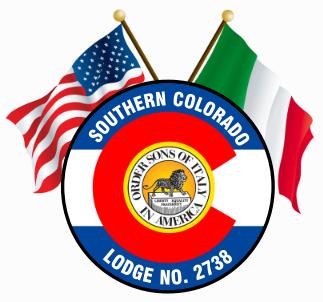

 Giovanni Bernini
Giovanni Bernini Leonardo da Vinci
Leonardo da Vinci Michelangelo
Michelangelo Christopher Columbus
Christopher Columbus  Amerigo Vespucci
Amerigo Vespucci  Raffaello Sanzio da Urbino
Raffaello Sanzio da Urbino


 Giovanni Giolitti
Giovanni Giolitti  Lee Iacocca
Lee Iacocca